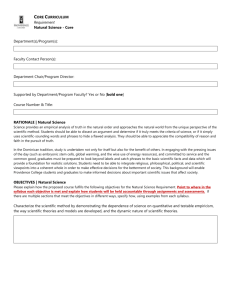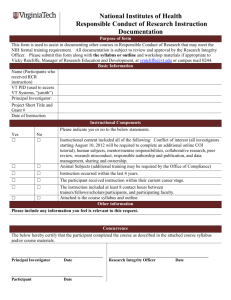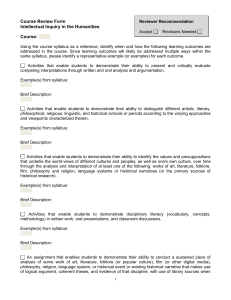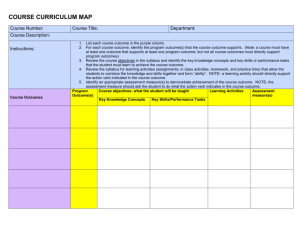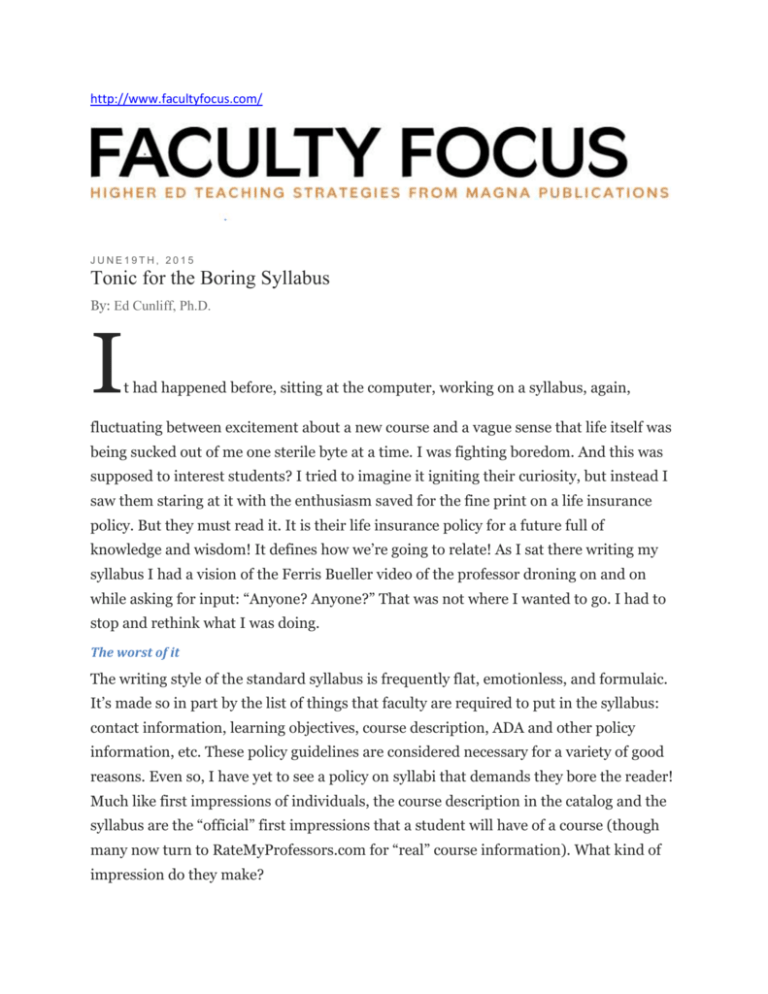
http://www.facultyfocus.com/
JUNE19TH, 2015
Tonic for the Boring Syllabus
By: Ed Cunliff, Ph.D.
I
t had happened before, sitting at the computer, working on a syllabus, again,
fluctuating between excitement about a new course and a vague sense that life itself was
being sucked out of me one sterile byte at a time. I was fighting boredom. And this was
supposed to interest students? I tried to imagine it igniting their curiosity, but instead I
saw them staring at it with the enthusiasm saved for the fine print on a life insurance
policy. But they must read it. It is their life insurance policy for a future full of
knowledge and wisdom! It defines how we’re going to relate! As I sat there writing my
syllabus I had a vision of the Ferris Bueller video of the professor droning on and on
while asking for input: “Anyone? Anyone?” That was not where I wanted to go. I had to
stop and rethink what I was doing.
The worst of it
The writing style of the standard syllabus is frequently flat, emotionless, and formulaic.
It’s made so in part by the list of things that faculty are required to put in the syllabus:
contact information, learning objectives, course description, ADA and other policy
information, etc. These policy guidelines are considered necessary for a variety of good
reasons. Even so, I have yet to see a policy on syllabi that demands they bore the reader!
Much like first impressions of individuals, the course description in the catalog and the
syllabus are the “official” first impressions that a student will have of a course (though
many now turn to RateMyProfessors.com for “real” course information). What kind of
impression do they make?
The meta communication
The concept of meta-communication suggests that the form of the communication, its
nonverbal elements, begin to define the teacher-student relationship. So what
relationship do I want with my students? What kind of first impression am I interested
in making through my syllabus?
Why not a question or two on the first page? What do you already know about (class
title)? What do you hope to learn about …? How will you use …?
I know that students will have some idea of the course based on its title. They will also
have an image of a faculty member. They more than likely will project past educational
experiences on the course and expect what they have experienced to continue. They
don’t arrive in my course as blank slates.
I want to inspire curiosity about my field. I’m passionate about it and want them to see
that passion. I’m also a lifelong learner and don’t want to hide that either. In fact, I’d like
to encourage them to join me on that journey so that we can learn from each other.
Hopefully they will know immediately that this is a unique course and that their
participation will help make it so. I’d like them to see the immediate relevance of the
course and get a sense that their perspective and experience matter. Those are the
messages I want to convey in the syllabus, and here are some of the ways I’ve tried
communicating them. It’s still a work in progress.
Succinctly stated strategic syllabi suggestions
I start by trying to get their attention visually. If everyone else is using Times Roman 12
font, I use something different. It still has to be readable, but many of those other font
options are. I include a picture of myself, usually a candid shot and a couple-ofsentences-long biography. I tend to go the route of my passion for the field, but I
consider identifying favorite hobbies equally appropriate.
Sometimes I add photos of prominent individuals in the field. I usually include a photo
or two of students interacting (no faces for identification) as a means of telling them that
we will be actively engaging each other. Quotes (again I like those by notables in the
field) are another way to add interest and pique curiosity. I can see using a quote from a
student offering some reaction or assessment of the course—a kind of endorsement
message.
Why not a question or two on the first page? What do you already know about (class
title)? What do you hope to learn about …? How will you use …? The use of questions
cues students that there will be interaction and that they are expected to engage. It also
tells them that questions are OK. Students should be asking them.
Actions, including those taken by students, have consequences. I go to pains to phrase
them positively. Some do threaten students with the loss of points for various behaviors,
but I try to support students. Class participation is a positive, for instance. Research
documents that engagement promotes learning, and I assume that students want to
learn. I am trying to set a climate that tells them this is a positive journey, and we are
taking the trip together. Wherever possible I will use the word “we,” hoping to open the
door for collaborative learning, with me as learner as well as their instructor.
In the end
I’m not proposing that we make our syllabi into marketing materials. We need to
describe course content accurately. We need to include the necessary policies. It is about
balance and recognizing the meta messages the syllabus conveys about the course. It’s
our first attempt to establish those relationships with students that promote learning.
My goal: I’m working to create a syllabus that puts life into the subject!
Ed Cunliff is a professor in the College of Education and Professional Studies at the
University of Central Oklahoma.
Reprinted from The Boring Syllabus, The Teaching Professor, 28.2 (2014): 5. © Magna
Publications. All rights reserved.





